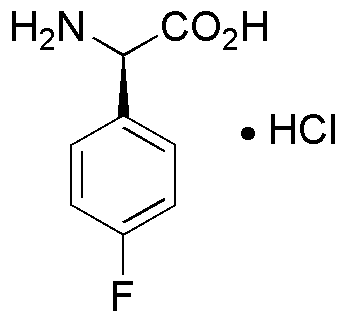(R)-4-Fluorophenylglycine hydrochloride is widely utilized in research focused on:
- Pharmaceutical Development: This compound serves as a key intermediate in the synthesis of various pharmaceuticals, particularly in the development of drugs targeting neurological disorders.
- Biochemical Research: It is used as a tool in studying amino acid transport mechanisms and receptor interactions, providing insights into cellular processes.
- Analytical Chemistry: The compound is employed in the development of analytical methods for detecting and quantifying amino acids in biological samples, enhancing the accuracy of research findings.
- Neuroscience Studies: Researchers utilize it to investigate the effects of amino acid derivatives on neurotransmitter systems, contributing to the understanding of brain function and disorders.
- Drug Design: Its unique structural properties make it valuable in structure-activity relationship studies, aiding in the design of more effective therapeutic agents.
General Information
Properties
Safety and Regulations
Applications
(R)-4-Fluorophenylglycine hydrochloride is widely utilized in research focused on:
- Pharmaceutical Development: This compound serves as a key intermediate in the synthesis of various pharmaceuticals, particularly in the development of drugs targeting neurological disorders.
- Biochemical Research: It is used as a tool in studying amino acid transport mechanisms and receptor interactions, providing insights into cellular processes.
- Analytical Chemistry: The compound is employed in the development of analytical methods for detecting and quantifying amino acids in biological samples, enhancing the accuracy of research findings.
- Neuroscience Studies: Researchers utilize it to investigate the effects of amino acid derivatives on neurotransmitter systems, contributing to the understanding of brain function and disorders.
- Drug Design: Its unique structural properties make it valuable in structure-activity relationship studies, aiding in the design of more effective therapeutic agents.
Documents
Safety Data Sheets (SDS)
The SDS provides comprehensive safety information on handling, storage, and disposal of the product.
Product Specification (PS)
The PS provides a comprehensive breakdown of the product’s properties, including chemical composition, physical state, purity, and storage requirements. It also details acceptable quality ranges and the product's intended applications.
Certificates of Analysis (COA)
Search for Certificates of Analysis (COA) by entering the products Lot Number. Lot and Batch Numbers can be found on a product’s label following the words ‘Lot’ or ‘Batch’.
Número de catálogo
Número de lote/lote
Certificates Of Origin (COO)
This COO confirms the country where the product was manufactured, and also details the materials and components used in it and whether it is derived from natural, synthetic, or other specific sources. This certificate may be required for customs, trade, and regulatory compliance.
Número de catálogo
Número de lote/lote
Safety Data Sheets (SDS)
The SDS provides comprehensive safety information on handling, storage, and disposal of the product.
DownloadProduct Specification (PS)
The PS provides a comprehensive breakdown of the product’s properties, including chemical composition, physical state, purity, and storage requirements. It also details acceptable quality ranges and the product's intended applications.
DownloadCertificates of Analysis (COA)
Search for Certificates of Analysis (COA) by entering the products Lot Number. Lot and Batch Numbers can be found on a product’s label following the words ‘Lot’ or ‘Batch’.
Número de catálogo
Número de lote/lote
Certificates Of Origin (COO)
This COO confirms the country where the product was manufactured, and also details the materials and components used in it and whether it is derived from natural, synthetic, or other specific sources. This certificate may be required for customs, trade, and regulatory compliance.


